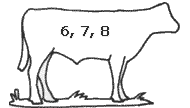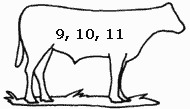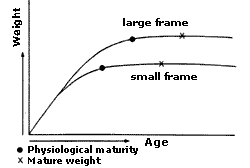
Frame scoring of beef cattle
Introduction
The height of a beef animal at a given age can be used as a measure of its maturity type, or growth curve potential. It may assist the breeder to determine where animals best fit into a breeding program—whether, for example, a bull is better suited to producing vealers or steers. Height can also be used as an aid to predict the growth and fattening pattern of a beast, as well as its mature size. In this way, frame size can be a helpful adjunct to other performance records when selecting stock. However, the best prediction of weight and performance of resultant progeny from breeding stock is obtained by using weight records expressed as 'estimated breeding values' (EBVs).
The height of the animal has also been found to be a useful indicator of animal performance in the feedlot—as an indicator of maturity. Taller animals generally grow more quickly and lay down less fat than do shorter animals (McKiernan et al. 1998). This is especially important when selecting feeder steers to be fattened for the long-fed Japanese trade.
A convenient way to discuss and evaluate height is in units of 'frame score' based on the height over the hips at a given age (refer to Table 3 and Table 4).
No one frame size for an animal will be best for all feed resources, breeding system and market specification. Overall economic return should determine the optimum frame size for individual situations.
Frame score is a convenient way of describing the skeletal size of cattle. Most animals should maintain the same frame score throughout their life, while actual height increases with age. This allows one frame score value to be used regardless of when the animal was evaluated. However, the frame score can change for animals that mature earlier or later than average animals within their frame group.
Environmental factors can also alter an animal’s growth rate from its genetic capability, and hence can alter its eventual height. Nutrition level is a major factor. Cattle fed less than adequate nutrition will grow more slowly and achieve a smaller size than that which the tables indicate, while cattle fed extremely high levels will grow faster but generally not much taller than the height indicated in the tables.
Frame scores should be used only as guides because inaccuracies can occur due to nutrition, as described above, but also due to other factors such as:
- inaccuracy of measurement (measuring the wrong spot on the back, or cattle not standing on level ground);
- angulation of joints—straight hocks and straight through the stifle joint can add considerably to the height of the animal, but not change its maturity pattern; however, it can considerably reduce the functionality of the animal.
How to evaluate body/frame type
The recommended point for linear height measurement is a point directly over the hips from a level surface.
Body type (frame) scores are made on a 1–11 basis. These body type scores were developed at the University of Wisconsin in the USA and are applicable to all breeds of cattle.
The frame score charts (Table 3 and Table 4) contained in this publication were adapted from a fact sheet from Kansas State University; however, they are understood to be universal. Most British breeds will fall into the 1–7 range, and most continental breeds in the 4–9 range. Frames 10 and 11 are extreme sizes. A score of 11 is not to be interpreted as the best—it merely indicates the largest type of cattle.
The height or 'frame' of cattle of a given age is closely related to maturity type (Table 1).
| Maturity type | Frame type score |
|---|---|
Early maturing—small framed (frame score l and 2):
|  |
Moderate maturing—average framed (frame score 3, 4 and 5):
|  |
Late maturing—large framed (frame score 6, 7 and 8):
|  |
Very late maturing—extreme framed (frame score 9, 10 and 11):
|  |
Frame type - growth and fattening relationships
Because the height or 'frame' of cattle of a given age is closely related to maturity type, the information can be used to categorise or classify a live animal, based on its growing and fattening pattern.
Large-framed and small-framed cattle grow at their quickest up until they reach physiological maturity (the stage of growth when fattening begins).

The smaller framed cattle reach that point at an earlier age and at a lighter weight than do large-framed cattle. As the smaller framed cattle slow down in growth and begin to fatten, the larger framed cattle continue growing for a while before they begin to fatten.
At any given weight, large-framed cattle will be younger and a little leaner than their small-framed counterparts. At the same age they will be heavier but have similar fat depth as that of the small-framed cattle (see Figure 1).
Therefore, you can change the 'market weight to fatness' relationship of the cattle you produce by using bulls of different frame types. For example, producers who find that their sale cattle get too fat before they reach the optimum weight can 'stretch out' and 'trim up' future progeny by using large-framed bulls, that is, later maturing types.
Environmental effects on frame size
Comparison between animals for any measurement is more meaningful where the animals being compared have been reared under similar environmental conditions.
The figures in Tables 3 and 4 are adjusted data based on age–height relation studies at the Universities of Missouri and Wisconsin, USA.
Heights of heifers are generally less than heights of bulls of the same age by 1–2.5 cm at 6 months, 2–5 cm at 8 months, and 5 cm at 12 months and over. Because of this, use Table 4 figures for assessing female cattle.
The economic importance of frame score
Frame score has no direct relationship with reproductive performance, growth rate or carcase quality. Indirectly, it may affect all these traits.
Frame score, as a predictor of maturity, certainly predicts when an animal is likely to achieve a finished slaughter weight.
As a result, steer fatteners, backgrounders and lotfeeders are usually careful to buy cattle which have moderate maturity (e.g. frame score 4–6). Their choice will be determined by the market they are targeting.
What are the frame score requirements for different markets?
The frame score requirements for the Australian domestic markets are relatively low because the greatest demand is for light carcases in the 180–230 kg range—although currently increasing. Understandably, carcase weights of up to 400 kg, needed by a segment of the Japanese market, will require much larger framed animals so that the animals do not become overfat, but not so large that the cattle are not able to be finished.
Table 2 should be used as a guide for feeder steers.
| Market | Days on feed | Optimal frame score |
|---|---|---|
| Domestic | 70–100 | 3–5 |
|
Export e.g. Japan short fed | 100–150 | 4–6 |
|
Export e.g. Japan long fed | 220–300 | 5–7 |
Frame score charts
| Age (months) | Bulls—hip height (cm) | ||||||||||
|---|---|---|---|---|---|---|---|---|---|---|---|
| Frame score | |||||||||||
| 1 | 2 | 3 | 4 | 5 | 6 | 7 | 8 | 9 | 10 | 11 | |
| 5 | 85 | 90 | 95 | 100 | 105 | 110 | 116 | 121 | 126 | 131 | 137 |
| 6 | 88 | 93 | 99 | 104 | 108 | 114 | 119 | 124 | 130 | 135 | 140 |
| 7 | 92 | 97 | 102 | 107 | 112 | 117 | 122 | 128 | 133 | 138 | 143 |
| 8 | 95 | 100 | 105 | 110 | 114 | 120 | 125 | 131 | 136 | 141 | 146 |
| 9 | 98 | 102 | 107 | 113 | 117 | 123 | 128 | 133 | 138 | 144 | 149 |
| 10 | 100 | 105 | 110 | 115 | 119 | 125 | 130 | 135 | 140 | 146 | 151 |
| 11 | 102 | 107 | 112 | 117 | 122 | 128 | 133 | 138 | 143 | 148 | 153 |
| 12 | 104 | 109 | 114 | 119 | 124 | 130 | 135 | 140 | 145 | 150 | 155 |
| 13 | 106 | 111 | 116 | 121 | 126 | 131 | 137 | 142 | 147 | 152 | 157 |
| 14 | 108 | 113 | 118 | 123 | 127 | 133 | 138 | 143 | 148 | 154 | 159 |
| 15 | 109 | 114 | 119 | 124 | 129 | 135 | 140 | 145 | 149 | 155 | 160 |
| 16 | 110 | 116 | 121 | 126 | 130 | 136 | 141 | 146 | 151 | 156 | 161 |
| 17 | 112 | 117 | 122 | 127 | 131 | 137 | 142 | 147 | 152 | 157 | 162 |
| 18 | 113 | 118 | 123 | 128 | 132 | 138 | 143 | 148 | 153 | 158 | 163 |
| 19 | 114 | 119 | 124 | 129 | 133 | 139 | 144 | 149 | 154 | 160 | 165 |
| 20 | 115 | 120 | 125 | 130 | 134 | 140 | 145 | 150 | 155 | 160 | 165 |
| 21 | 116 | 121 | 126 | 131 | 135 | 140 | 146 | 151 | 156 | 161 | 166 |
| Mature bulls | |||||||||||
| 24 | 118 | 123 | 128 | 133 | 137 | 142 | 147 | 152 | 157 | 163 | 168 |
| 30 | 120 | 125 | 130 | 135 | 139 | 145 | 150 | 155 | 160 | 165 | 170 |
| 36 | 122 | 127 | 132 | 137 | 141 | 146 | 151 | 156 | 161 | 166 | 171 |
| 48 | 123 | 128 | 133 | 137 | 142 | 147 | 152 | 157 | 162 | 167 | 172 |
| Age (months) | Females—hip height (cm) | ||||||||||
|---|---|---|---|---|---|---|---|---|---|---|---|
| Frame score | |||||||||||
| 1 | 2 | 3 | 4 | 5 | 6 | 7 | 8 | 9 | 10 | 11 | |
| 5 | 84 | 89 | 94 | 99 | 105 | 110 | 115 | 120 | 126 | 131 | 136 |
| 6 | 87 | 92 | 97 | 102 | 107 | 113 | 118 | 123 | 128 | 134 | 139 |
| 7 | 89 | 94 | 100 | 105 | 110 | 115 | 121 | 126 | 131 | 136 | 141 |
| 8 | 92 | 97 | 102 | 107 | 112 | 117 | 122 | 128 | 133 | 138 | 144 |
| 9 | 94 | 99 | 104 | 109 | 114 | 119 | 124 | 130 | 135 | 140 | 145 |
| 10 | 96 | 101 | 106 | 111 | 116 | 121 | 126 | 131 | 136 | 141 | 147 |
| 11 | 98 | 103 | 108 | 113 | 118 | 123 | 128 | 133 | 138 | 144 | 149 |
| 12 | 99 | 104 | 109 | 114 | 119 | 124 | 130 | 135 | 140 | 145 | 150 |
| 13 | 101 | 105 | 110 | 116 | 121 | 126 | 131 | 136 | 141 | 146 | 151 |
| 14 | 102 | 107 | 112 | 117 | 122 | 127 | 132 | 137 | 142 | 147 | 152 |
| 15 | 103 | 108 | 113 | 118 | 123 | 128 | 133 | 138 | 143 | 148 | 153 |
| 16 | 104 | 109 | 114 | 119 | 124 | 129 | 134 | 139 | 144 | 149 | 154 |
| 17 | 105 | 110 | 115 | 120 | 125 | 130 | 135 | 140 | 145 | 149 | 154 |
| 18 | 106 | 110 | 116 | 121 | 126 | 131 | 135 | 140 | 145 | 150 | 155 |
| 19 | 107 | 111 | 116 | 121 | 126 | 131 | 136 | 141 | 146 | 151 | 156 |
| 20 | 107 | 112 | 117 | 122 | 127 | 132 | 137 | 141 | 146 | 151 | 156 |
| 21 | 108 | 113 | 118 | 123 | 128 | 132 | 137 | 142 | 147 | 152 | 157 |
| Mature cows | |||||||||||
| 24 | 109 | 114 | 119 | 124 | 129 | 133 | 138 | 143 | 148 | 153 | 157 |
| 30 | 111 | 116 | 121 | 125 | 130 | 135 | 140 | 145 | 150 | 154 | 159 |
| 36 | 112 | 117 | 122 | 126 | 132 | 136 | 141 | 145 | 150 | 155 | 160 |
| 48 | 113 | 118 | 122 | 127 | 132 | 137 | 142 | 146 | 151 | 155 | 160 |
Summary
Frame score has been abused in its use to indicate superiority of one animal over another because of its height. Quite often people have relied on frame score to indicate weight when it would be far more sensible just to weigh the animal. With breeding cattle, weights can be used to produce EBVs—a much better predictor of weight.
As we have discussed, frame score can be a useful tool to indicate maturity of an animal. However, it should not be used in preference to other easily measured traits which give a better indication of market suitability or fitness for purpose.
In breeding cattle particularly, balanced selection for a number of productive traits which include fertility, growth and carcase quantity and quality should be practised.
Reference
McKiernan W. A., Hoffman W., Barwick S. A. and Johnston D. J. 1998, 'Feeder Steer Assessments that are Guides to Feedlot and Carcass Performance', Proceedings of the Beef Products Conference, NSW Agriculture, Armidale.
Acknowledgments
The original NSW Agriculture Agfact on frame scoring was written by Bob Freer, then of NSW Agriculture. This new edition of the Agfact has been based on that first edition, on information provided by Sandy Yeates, then of NSW Agriculture, and on fact sheets produced by Kansas State University.

